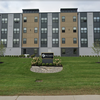Guilderland district faces multi-million-dollar budget gap
GUILDERLAND — “Uncertainty” was the word Neil Sanders repeated again and again as he explained the challenges in developing next year’s budget for the Guilderland schools.
The district is facing a budget gap next year ranging from $2.5 million in the best-case scenario to $8.6 million in the worst-case scenario, and is looking for advice from the public through an online thoughtexchange.
The budget itself could range from $106 million to $107 million.
Sanders, the district’s assistant superintendent for business, outlined his dilemma at a Jan. 13 forum.
In his 20 years of developing school budgets, Sanders said, he’s “never had the level of uncertainty we’re facing this year.”
Usually, he said, schools have an idea in mid-January from the governor’s budget proposal on what their state aid will be although the state legislature doesn’t sign off till April.
On Tuesday, Andrew Cuomo’s budget proposal didn’t make the picture on state aid any clearer for Sanders and his counterparts at districts across the state.
Cuomo outlined two distinct budget options: one that was generous to schools, based on New York State receiving $15 billion in federal aid, and the other that would be painful for schools if that aid is not forthcoming.
The first option would provide $31.7 billion in funding for school districts through School Aid, STAR, and federal funds, to support operational costs of school districts as well as allocating $4.3 billion in federal supplemental funds to support ongoing operational and pandemic-related costs in schools.
Robert Schneider, who directs the New York State School Boards Association, responded in a statement, “We remain concerned with the governor’s proposals to help balance the state’s budget at the expense of school districts. Those proposals include: using federal money to offset state aid cuts, reducing and consolidating categorical aids, limiting reimbursement for the steps districts took to keep their transportation programs intact last spring and eliminating prior year aid claims.”
“We are profoundly opposed to federal funds being used to replace state dollars to support our schools,” wrote the new Regents chancellor, Lester Young, in a statement with the state’s interim commissioner of education, Betty Rosa.
Guilderland, like other districts across New York still does not know if the state will withhold up to 20 percent of aid for this school year. Some districts made massive layoffs in anticipation of the reduction.
Since suburban districts typically rely less on state aid than their urban and rural counterparts, a 20-percent reduction would have less impact on schools like Guilderland. State aid covered roughly a quarter of this year’s $103 million Guilderland school budget.
“We and many of our Suburban Council counterparts have not adopted the strategy of layoffs,” said Sanders. “We decided to ride that out.”
So far, following public outcry, the state has not withheld aid this school year. “We’re still optimistic that won’t occur,” said Sanders.
But Guilderland’s uncertainty goes further than state and federal aid questions. As in the rest of the nation, there is no certainty on when the pandemic will be contained nor on the effect new strains of the coronavirus will have.
This, in turn, leads to uncertainty on what instructional model Guilderland will use next year. During the current school year and on into the second semester, students were given a choice of whether they wanted to learn remotely at home or to come to school for social-distanced in-person classes.
Students in kindergarten through seventh grade can attend class in school. Students in eighth through 12th grades have a hybrid schedule, alternating days of in-person classes with remote instruction.
Staffing is a large part of a school budget and costs vary depending on the instructional model.
“At this point, we have hope the vaccine will work and we’ll be able to return to school as normal next year,” said Sanders.
In order to proceed with budget planning, Guilderland has developed three scenarios: best case, expected case, and worst case. Sanders said that this approach will give him “a range to work within.”
Sanders has worked through estimates of both expenses and revenues for each of these three scenarios.
The best-case budget for next year would be $106.1 million, about $3 million more than this year. The worst-case budget would be about $107.1 million, about $4 million more than this year.
The expected budget would be in between, about three-and-a-half-million dollars more than this year, at $106,635,644.
Looking at just one major expenditure, instructional salaries could range from $46.5 million to $46.8 million next year. Those calculations depend, in part, on how many teachers retire.
A best-case scenario — “best” because new hires are paid far less than long-term teachers — would see 30 teachers retire while a worst-case scenario would see just 10 teachers retire.
Sanders said the district has an incentive in every one of its contracts for employees to inform the district by Feb. 1 of retirement by June 30 so that that savings in salary can be taken into account in drafting the budget.
Benefits are another major expense and would range from $27.5 million to $28.1 million. Part of this depends on how much the district is required to pay into a teachers’ retirement fund, which could range from 9.5 percent to 10 percent, and also on health-insurance increases, which could range from 4.5 percent to 6.5 percent.
On the revenue side, Guilderland has calculated state aid, ranging from $20 million to nearly $25 million.
Under the state-set tax-levy limit, the most Guilderland can raise in property taxes is $76,160,475, Sanders calculated. To go over that amount would take a supermajority, 60 percent, of the vote at the polls. Guilderland has always stayed under the state-set limit.
Although it is popularly called a 2-percent tax cap, the levy limit is calculated as the lesser of the rate of inflation or 2 percent with certain exceptions, and a complex formula is used to determine the exact rate for each school district.
The state’s comptroller, Thomas DiNapoli, released data on Jan. 13 showing property tax levy growth for school districts will be capped at 1.23 percent, down from 1.81 percent last year.
The budget gap for Guilderland next year ranges from $2.5 million in the best-case scenario to $8.6 million in the worst-case scenario.
The middle-of-the-road expected scenario shows a $5.6 million gap.
In all three scenarios, Sanders has listed Guilderland as using $638,940 from its fund balance.
The district currently has a fund balance of $4.1 million as well as restricted reserves of $6.6 million.
Sanders cautioned against filling a budget gap with money from the fund balance. “We’ll have a revenue hole …,” he said. “It’s not an endless pot of money.”
He also said, “We don’t have a good way to cover that revenue gap.”
“We’re very much interested in guidance and advice from our community,” said Superintendent Marie Wiles. The district has launched an online “thoughtexchange,” an anonymous forum, at www. Guilderlandschools.org.
Wiles said the district will take the public’s comments to heart.



